Water stewardship
Fresh water is a finite natural resource that needs to be used and managed in a responsible and sustainable way. Water stress is becoming increasingly important to the world, accelerated by climate-related extreme weather, and impacting biodiversity. Our operations rely on stable supplies of high-quality freshwater for utilities and production. Our goal is to ensure its use without disturbing the local balances.
|
|
Aspiration |
|
2022 |
|
2021 |
||||||||
|---|---|---|---|---|---|---|---|---|---|---|---|---|---|---|
|
|
|
|
|
|
|
||||||||
Water Use (million m3)1 |
|
|
|
|
|
|
||||||||
Water withdrawal in water-stressed areas2 |
|
|
|
10.6 |
|
10.9 |
||||||||
Water withdrawal for non-OTC |
|
|
|
26 |
|
26 |
||||||||
Consumptive Use |
|
|
|
5.5 |
|
5.3 |
||||||||
|
|
|
|
|
|
|
||||||||
Sustainable water management |
|
|
|
|
|
|
||||||||
Water withdrawal efficiency improvement |
|
> 0% |
|
-7.0%3 |
|
8.0% |
||||||||
Water withdrawal efficiency improvement – water-stress sites versus 2020 |
|
10% by 2030 |
|
7.2% |
|
7.8% |
||||||||
|
|
|
|
|
|
|
||||||||
Emissions to water |
|
|
|
|
|
|
||||||||
Chemical Oxygen Demand (COD, kt) |
|
|
|
1.9 |
|
2.0 |
||||||||
|
||||||||||||||
Commitments, policy and governance
DSM is a signatory of the CEO Water Mandate, a UN Global Compact initiative to advance water stewardship and drive progress on SDG 6 (Clean Water and Sanitation). We commit to measuring, monitoring and reporting relevant performance indicators for water. We disclose our progress via the CDP Water Security questionnaire. In 2022, our CDP Water Security rating was an A, in recognition of our ongoing efforts in sustainable water management.
Water security is an integral part of our risk mitigation and environmental impact reduction strategies. Our water policy is part of our SHE policy and specifies the goal, governance and management standards on water management.
Impacts and dependencies
Water is not a primary ingredient in our products. Our primary water use is in utility systems, as a process medium and for cleaning purposes. Water is also used in our upstream supply chain, for agriculture-related as well as industrial raw materials.
A large proportion of our total water withdrawal (approximately 75%) is used for once-through cooling (OTC) purposes in low water-stress areas. The risk exposure and environmental impact of OTC are limited. The other 25% of our water withdrawal is for non-OTC purposes: this is the focus of our key performance indicators and targets on water. According to our water risk screening in 2022, 40% of our non-OTC withdrawal is from a current water-stressed area, or a water-stressed area in 2030.
Water withdrawal
in million m3
Water-related targets
We strive to continuously improve water withdrawal efficiency for our production facilities. In early 2021, we announced a context-based water reduction target to improve water withdrawal efficiency in water-stressed areas by 10% by 2030 versus 2020. We started a water reduction program covering 22 sites in an existing or future water-stressed area. Several large sites in water-stressed areas improved their site-level water balance in 2022, through better leakage detection and prevention.
Our overall water efficiency versus 2021 was negatively influenced by providing additional water management services on one large site (executed for a neighboring company), leading to a significant increase in water withdrawal. This was combined with lower production volumes, resulting in a lower water efficiency in 2022 compared to 2021.
Some sites also executed water reduction projects, often in close collaboration with energy reduction projects. For example, in our Chifeng site (Inner Mongolia province, China), improvements were made to optimize the site cooling water system, allowing both GHG savings and more than 40,000 m3 water saving, improving site resilience to increasing water stress. Unfortunately, the executed water efficiency projects were compensated by negative production volume and product mix influences at several important sites in 2022, resulting in a slightly lower water efficiency improvement than in 2021.
For effluent management, our sites set site-specific pollution reduction targets, based on business context and current and future regulatory requirements. For example, our site in Lalden (Switzerland) significantly reduced its use of acetic acid, thereby reducing the quantity of COD in effluents.
Risk management
All sites with water withdrawal materiality and sites in water-stressed areas are required to conduct a site-level water risk assessment (WRA). The frequency of the assessment is specified in DSM’s water management standard. In 2022, we reached a WRA coverage of 96%, evaluating 5 sites newly identified to be in a water-stressed area based on the 2021 water risk screening.
Water quality remains the most important water-related risk, often related to enabling business growth or increasingly stringent regulatory requirements. For identified high risks, the site defines short-term measures to address the immediate issue(s) and/or long-term measures including technical projects to reduce pollutant level at source or upgrades of the wastewater treatment facility. For example, we are executing a capacity expansion project for the wastewater treatment plant (WWTP) in Village-Neuf (France), including upgrades to add additional treatment steps.
In our value chain, we monitor the water impact of our largest suppliers through value chain engagement programs such as Together for Sustainability (TfS) and the Ecovadis water specific questions.
Primary energy is energy that has not yet been subjected to a human engineered conversion process. It is the energy contained in unprocessed fuels.
Final (consumed) energy is the energy that is consumed by end-users. The difference between primary energy and final consumed energy is caused by the conversion process between the two as well as any transmission losses.




